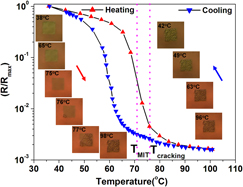Crossref Citations
This article has been cited by the following publications. This list is generated based on data provided by
Crossref.
Sim, Jai S.
Zhou, You
and
Ramanathan, Shriram
2012.
Suspended sub-50 nm vanadium dioxide membrane transistors: fabrication and ionic liquid gating studies.
Nanoscale,
Vol. 4,
Issue. 22,
p.
7056.
Marini, C.
Pascarelli, S.
Mathon, O.
Joseph, B.
Malavasi, L.
and
Postorino, P.
2013.
Tracking competitive lattice distortions in strongly correlated VO
2
-based systems: A temperature-dependent EXAFS study
.
EPL (Europhysics Letters),
Vol. 102,
Issue. 6,
p.
66004.
Kerman, Kian
Van Overmeere, Quentin
Karpelson, Michael
Wood, Robert J.
and
Ramanathan, Shriram
2013.
Monolithic Integration of Nanoscale Solid Oxide Fuel Cell Membranes onto Polymer Scaffolds through Stress Control.
ACS Nano,
Vol. 7,
Issue. 12,
p.
10895.
Kerman, Kian
and
Ramanathan, Shriram
2014.
Complex oxide nanomembranes for energy conversion and storage: A review.
Journal of Materials Research,
Vol. 29,
Issue. 3,
p.
320.
Van Overmeere, Quentin
and
Ramanathan, Shriram
2014.
Thin film fuel cells with vanadium oxide anodes: Strain and stoichiometry effects.
Electrochimica Acta,
Vol. 150,
Issue. ,
p.
83.
Asayesh-Ardakani, Hasti
Nie, Anmin
Marley, Peter M.
Zhu, Yihan
Phillips, Patrick J.
Singh, Sujay
Mashayek, Farzad
Sambandamurthy, Ganapathy
Low, Ke-bin
Klie, Robert F.
Banerjee, Sarbajit
Odegard, Gregory M.
and
Shahbazian-Yassar, Reza
2015.
Atomic Origins of Monoclinic-Tetragonal (Rutile) Phase Transition in Doped VO2 Nanowires.
Nano Letters,
Vol. 15,
Issue. 11,
p.
7179.
Grebenyuk, A.G.
Kaurkovskaya, V.N.
and
Lobanov, V.V.
2015.
Theoretical study on the pressure-induced phase transition in vanadium dioxide.
Himia, Fizika ta Tehnologia Poverhni,
Vol. 6,
Issue. 2,
p.
211.
Zhang, Peng
Huang, Ting
You, Qinghu
Zhang, Jinzhong
Li, Wenwu
Wu, Jiada
Hu, Zhigao
and
Chu, Junhao
2015.
Effects of crystal orientation on electronic band structure and anomalous shift of higher critical point in VO2 thin films during the phase transition process.
Journal of Physics D: Applied Physics,
Vol. 48,
Issue. 48,
p.
485302.
Jian, Jie
Chen, Aiping
Chen, Youxing
Zhang, Xinghang
and
Wang, Haiyan
2017.
Roles of strain and domain boundaries on the phase transition stability of VO2 thin films.
Applied Physics Letters,
Vol. 111,
Issue. 15,
Kienle, Daniel F.
Ventrici de Souza, João
and
Kuhl, Tonya L.
2017.
Large-area release and transfer of ultrathin, freestanding nanocrystalline ceria films.
Thin Solid Films,
Vol. 638,
Issue. ,
p.
318.
Lauzier, J
Sutton, L
and
de la Venta, J
2018.
Magnetic irreversibility in VO2/Ni bilayers.
Journal of Physics: Condensed Matter,
Vol. 30,
Issue. 37,
p.
374004.
Moatti, Adele
Sachan, Ritesh
Cooper, Valentino R
and
Narayan, Jagdish
2019.
Electrical Transition in Isostructural VO2 Thin-Film Heterostructures.
Scientific Reports,
Vol. 9,
Issue. 1,
Alphonse, Carmel Mary Esther
Garlapati, Mohan Muralikrishna
Hilke, Sven
and
Wilde, Gerhard
2020.
Double shadow masking sample preparation method for in‐situ TEM characterization.
Nano Select,
Vol. 1,
Issue. 4,
p.
413.
Rodríguez, Laura
del Corro, Elena
Conroy, Michele
Moore, Kalani
Sandiumenge, Felip
Domingo, Neus
Santiso, José
and
Catalan, Gustau
2020.
Self-Pixelation Through Fracture in VO2 Thin Films.
ACS Applied Electronic Materials,
Vol. 2,
Issue. 5,
p.
1433.
Verma, Divya
Singh, Davinder
and
Balakrishnan, Viswanath
2022.
Fracture toughness of VO2 microcrystals across metal-insulator transition.
Materials Letters,
Vol. 315,
Issue. ,
p.
132006.
Das, Sujan Kumar
Nandi, Sanjoy Kumar
Marquez, Camilo Verbel
Rúa, Armando
Uenuma, Mutsunori
Puyoo, Etienne
Nath, Shimul Kanti
Albertini, David
Baboux, Nicolas
Lu, Teng
Liu, Yun
Haeger, Tobias
Heiderhoff, Ralf
Riedl, Thomas
Ratcliff, Thomas
and
Elliman, Robert Glen
2023.
Physical Origin of Negative Differential Resistance in V3O5 and Its Application as a Solid‐State Oscillator.
Advanced Materials,
Vol. 35,
Issue. 8,
Zhang, Yuwei
Fincher, Cole D.
Gurrola, Rebeca M.
Serem, Wilson
Zhao, Dexin
Shin, Jungho
Banerjee, Sarbajit
Xie, Kelvin
Shamberger, Patrick
and
Pharr, Matt
2023.
Strategic texturation of VO2 thin films for tuning mechanical, structural, and electronic couplings during metal-insulator transitions.
Acta Materialia,
Vol. 242,
Issue. ,
p.
118478.
Suresh, E. K.
Arun, B.
Andrews, J.
Akhil Raman, T. S.
Nikhil Mohan, P.
Shivakumar, C.
and
James Raju, K. C.
2025.
Role of buffer layers on the strain-induced insulator-metal transition of VO
2
thin films: a review
.
Critical Reviews in Solid State and Materials Sciences,
Vol. 50,
Issue. 2,
p.
137.



